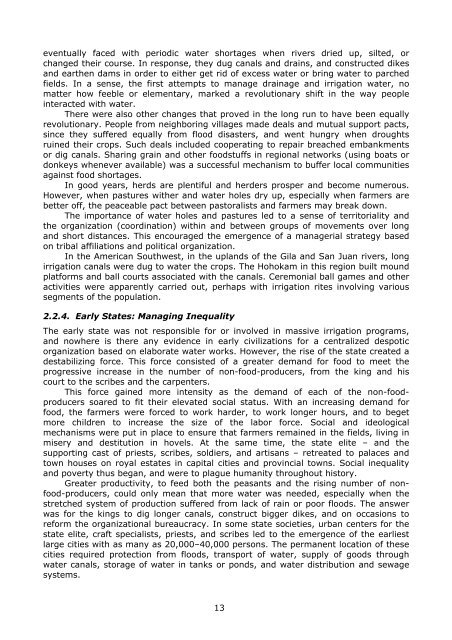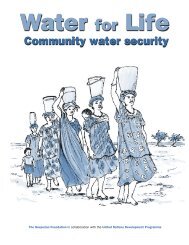Water security and peace: a synthesis of studies ... - unesdoc - Unesco
Water security and peace: a synthesis of studies ... - unesdoc - Unesco
Water security and peace: a synthesis of studies ... - unesdoc - Unesco
Create successful ePaper yourself
Turn your PDF publications into a flip-book with our unique Google optimized e-Paper software.
eventually faced with periodic water shortages when rivers dried up, silted, or<br />
changed their course. In response, they dug canals <strong>and</strong> drains, <strong>and</strong> constructed dikes<br />
<strong>and</strong> earthen dams in order to either get rid <strong>of</strong> excess water or bring water to parched<br />
fields. In a sense, the first attempts to manage drainage <strong>and</strong> irrigation water, no<br />
matter how feeble or elementary, marked a revolutionary shift in the way people<br />
interacted with water.<br />
There were also other changes that proved in the long run to have been equally<br />
revolutionary. People from neighboring villages made deals <strong>and</strong> mutual support pacts,<br />
since they suffered equally from flood disasters, <strong>and</strong> went hungry when droughts<br />
ruined their crops. Such deals included cooperating to repair breached embankments<br />
or dig canals. Sharing grain <strong>and</strong> other foodstuffs in regional networks (using boats or<br />
donkeys whenever available) was a successful mechanism to buffer local communities<br />
against food shortages.<br />
In good years, herds are plentiful <strong>and</strong> herders prosper <strong>and</strong> become numerous.<br />
However, when pastures wither <strong>and</strong> water holes dry up, especially when farmers are<br />
better <strong>of</strong>f, the <strong>peace</strong>able pact between pastoralists <strong>and</strong> farmers may break down.<br />
The importance <strong>of</strong> water holes <strong>and</strong> pastures led to a sense <strong>of</strong> territoriality <strong>and</strong><br />
the organization (coordination) within <strong>and</strong> between groups <strong>of</strong> movements over long<br />
<strong>and</strong> short distances. This encouraged the emergence <strong>of</strong> a managerial strategy based<br />
on tribal affiliations <strong>and</strong> political organization.<br />
In the American Southwest, in the upl<strong>and</strong>s <strong>of</strong> the Gila <strong>and</strong> San Juan rivers, long<br />
irrigation canals were dug to water the crops. The Hohokam in this region built mound<br />
platforms <strong>and</strong> ball courts associated with the canals. Ceremonial ball games <strong>and</strong> other<br />
activities were apparently carried out, perhaps with irrigation rites involving various<br />
segments <strong>of</strong> the population.<br />
2.2.4. Early States: Managing Inequality<br />
The early state was not responsible for or involved in massive irrigation programs,<br />
<strong>and</strong> nowhere is there any evidence in early civilizations for a centralized despotic<br />
organization based on elaborate water works. However, the rise <strong>of</strong> the state created a<br />
destabilizing force. This force consisted <strong>of</strong> a greater dem<strong>and</strong> for food to meet the<br />
progressive increase in the number <strong>of</strong> non-food-producers, from the king <strong>and</strong> his<br />
court to the scribes <strong>and</strong> the carpenters.<br />
This force gained more intensity as the dem<strong>and</strong> <strong>of</strong> each <strong>of</strong> the non-foodproducers<br />
soared to fit their elevated social status. With an increasing dem<strong>and</strong> for<br />
food, the farmers were forced to work harder, to work longer hours, <strong>and</strong> to beget<br />
more children to increase the size <strong>of</strong> the labor force. Social <strong>and</strong> ideological<br />
mechanisms were put in place to ensure that farmers remained in the fields, living in<br />
misery <strong>and</strong> destitution in hovels. At the same time, the state elite – <strong>and</strong> the<br />
supporting cast <strong>of</strong> priests, scribes, soldiers, <strong>and</strong> artisans – retreated to palaces <strong>and</strong><br />
town houses on royal estates in capital cities <strong>and</strong> provincial towns. Social inequality<br />
<strong>and</strong> poverty thus began, <strong>and</strong> were to plague humanity throughout history.<br />
Greater productivity, to feed both the peasants <strong>and</strong> the rising number <strong>of</strong> nonfood-producers,<br />
could only mean that more water was needed, especially when the<br />
stretched system <strong>of</strong> production suffered from lack <strong>of</strong> rain or poor floods. The answer<br />
was for the kings to dig longer canals, construct bigger dikes, <strong>and</strong> on occasions to<br />
reform the organizational bureaucracy. In some state societies, urban centers for the<br />
state elite, craft specialists, priests, <strong>and</strong> scribes led to the emergence <strong>of</strong> the earliest<br />
large cities with as many as 20,000–40,000 persons. The permanent location <strong>of</strong> these<br />
cities required protection from floods, transport <strong>of</strong> water, supply <strong>of</strong> goods through<br />
water canals, storage <strong>of</strong> water in tanks or ponds, <strong>and</strong> water distribution <strong>and</strong> sewage<br />
systems.<br />
13
















